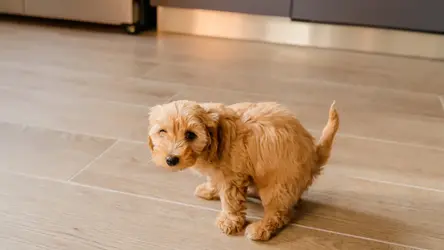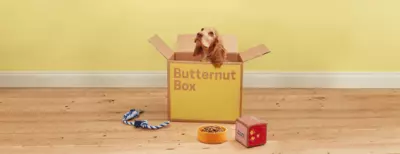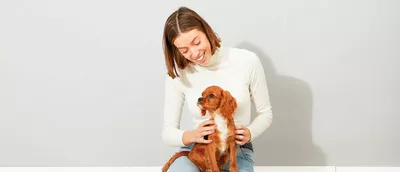How to Toilet Train a Puppy
- 29 Nov 2023
- 7m read

Advice from our very own Butternut Box Ambassador, Meera Puppins. Meera is an IMDT qualified Dog Trainer specialising in puppy training and socialisation, across the Sheffield area.
How Often Do Puppies Need to Pee?
How often your puppy needs the toilet really depends on your puppy.
It’s old advice, but good advice, that puppies usually need to wee when they wake up from a nap, when they’ve finished eating, or after a fun play session. This is because all of these activities involve movement, which can trigger a “Ooh I need a wee” feeling in your puppy.
Similarly to us, puppies can need the toilet as soon as they wake up. When they’re asleep, their bladders are also asleep. When they wake up, their bladders wake up too.
As puppies grow older, they start to develop bladder control, which means they start learning to hold their bladders for a bit longer. In the interim, it’s important to be really patient with them and teach them good toileting habits. Under no circumstances should you restrict their access to water - this is a cruel and unnecessary practice.
How Long Does it Take to Toilet Train a Puppy?
It can take weeks, or months to toilet train a puppy. The important thing is to be consistent with your training and don’t get disheartened if it takes you longer than you thought it would.
When it comes to toilet training, there can also be setbacks along the way too.
I remember working privately with a puppy client who was worried that they weren’t making any progress with their puppy’s toilet training. In our first training session I noticed that their puppy’s toileting habits weren’t what I’d consider normal, and I was pretty sure she was showing signs of a urinary infection. We paused our training, the puppy went to see the vet where she was diagnosed with a UTI, and got the treatment she needed. After that, it was pretty much plain sailing.
If you’re ever in doubt about your puppy’s toilet training habits please do consult your vet to rule out any medical issues.
There’s a couple of things you can do to fast-track your puppy’s toilet training, I’ve listed my top three tips below:
1. Keep a diary
Although it’s unlikely to be a bestseller, it will be helpful for you to note down the times / places your puppy goes to the loo. By keeping a diary it becomes much easier to pre-empt toileting times, and to ensure your puppy is in the garden when they need to go - and not on your lovely lounge rug.
2. Actively toilet train your puppy
By that, I mean you need to go outside with your pup, and supervise them until they’ve been to the toilet. This way you can also avoid accidents indoors. Try and avoid simply leaving the backdoor open - unfortunately this won’t mean much to your puppy, who may still choose the warm comfy spots underneath your dining room table when they need a wee - especially in the Autumn and Winter months.
3. Don’t get annoyed
I really appreciate how frustrating it is when your puppy has accidents indoors. During the pandemic I fostered a rescue greyhound who wasn’t toilet trained (he had lived in kennels for almost 6 years, and never lived in a house before). The day I brought him home I took him for a toilet walk before we went inside, only for him to come inside and wee all over my lovely shoes - I was upset, but it wasn’t his fault at all. We had plenty more accidents over the next few weeks until we got the hang of everything together. Patience is definitely important.
What Age Should a Puppy Be Toilet Trained?
Ideally, your puppy should be reliably toilet trained by about six months of age (notwithstanding any medical issues of course).
However, it’s important to remember that your puppy is an individual being, and you play a huge role in their toilet training.
Let me give you an example. I previously worked with a gorgeous Labrador puppy called Jet, who was a private puppy training client. His owners were keen for Jet to master his toilet training quite quickly, so I advised and supported them. Within a couple of weeks (with lots of hard work from his owners) Jet was reliably toilet trained.
In this case, toilet training was a relatively quick and easy process. It can be hard to achieve this on your own, so don’t be embarrassed to ask for help if you need it. If you’re working with a trainer, please do ensure that they are accredited and only practise positive training techniques.
Are Puppy Pads a Good Idea?
If your puppy has hurt themselves doing the zoomies (or similar) and your vet has advised for them to be on strict bed/crate rest, then yes, puppy pads could be a good idea for toilet training your puppy, as this could help to minimise the risk of further injury.
In fact, a puppy at my small-group puppy training classes actually broke her toe from doing super fast zoomies at home, and her owner had to use puppy pads for toilet training, simply because the bandage needed to be kept clean and dry all times - which meant wrapping it in a plastic bag when puppy needed a wee. As you can imagine, this was quite a time-consuming process, so it was easier to use puppy pads in these circumstances.
However, if you’re using puppy pads to try and toilet train your puppy (medical issues notwithstanding), I’d actually advise against it. By using puppy pads you’re actually creating an indoor toilet for your puppy. This completely defeats the purpose of what you’re actually trying to achieve - which is to get your puppy to wee and poop outside.
Should I Put Puppy Pads in Crate at Night?
Again - if there are special circumstances and your vet has advised you to do this, then absolutely follow your vet’s guidance and advice.
However, in the majority of cases, it would be a “no” to putting puppy pads in their crate at night. Puppies (and animals in general) don’t like to sleep or eat where they defecate or urinate - which is perfectly understandable.
By putting puppy pads in your pup’s crate at night, you may be inadvertently encouraging them to use their crate as a toilet. This comes with its own problems, including the risk that your puppy no longer sees their crate as a safe space, or as a den, where they want to spend time relaxing or eating.
What I would recommend as an alternative to putting puppy pads in their crate at night is to sleep near your puppy, so if they wake up at night, you can quietly and quickly whisk them out into the garden for the loo. If it’s not possible to sleep near them at night, keep your bedroom door open, so you’ve got a better chance of hearing them if they wake.
How Do I Know If My Puppy Needs to Pee at Night?
The best way to know if your puppy needs to have a wee during the night, is by sleeping near them - close enough to hear them if they wake up. If your puppy wakes up at night, they may need a wee due to their bladder also waking up too. Sometimes puppies cry or whine at night, this could be another sign that they need to go out for a wee. Equally, if your puppy seems restless or unable to settle, this could be because they need the loo.
However, if you’re unable to sleep near your puppy at night (or vice versa) it may be worth considering getting a baby monitor (or similar) so you can hear them if they wake up in the night, and check on them to make sure they’re ok.
If your puppy does need the loo during the night, take them outside (always supervising them) let them do their business, and then gently settle them back to sleep again.

.jpeg)
.webp)

